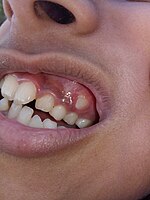
Photo from wikipedia
ABSTRACT Objective: The aim of this retrospective study was to evaluate the cephalometric and occlusal changes of orthodontically treated Class III malocclusion patients. Methods: The experimental groups comprised 37 Class… Click to show full abstract
ABSTRACT Objective: The aim of this retrospective study was to evaluate the cephalometric and occlusal changes of orthodontically treated Class III malocclusion patients. Methods: The experimental groups comprised 37 Class III patients treated: G1) without (n=19) and G2) with extractions (n=18) . The control group (G3), matched by age and sex with the experimental groups, consisted of 18 subjects with untreated Class III malocclusion. Cephalometric (radiographs) and occlusal (study models) changes were assessed between the beginning (T1) and the end (T2) of treatment. Intergroup comparisons were performed with one-way ANOVA followed by Kruskal-Wallis tests (p< 0.05). Occlusal changes were evaluated by the peer assessment rating (PAR) index (ANOVA and Kruskal-Wallis tests), and the treatment outcomes were evaluated by the Objective Grading System (OGS) (t-tests). Results: The experimental groups showed a restrictive effect on mandibular anterior displacement and a discrete improvement in the maxillomandibular relationship. Extraction treatment resulted in a greater retrusive movement of the incisors and significant improvements in the overjet and molar relationship in both groups. The PAR indexes were significantly reduced with treatment, and the OGS scores were 25.6 (G1) and 28.6 (G2), with no significant intergroup difference. Conclusions: Orthodontic treatment of Class III malocclusion patients with fixed appliances improved the sagittal relationships, with greater incisor retrusion in the extraction group. Both the extraction and non-extraction treatments significantly decreased the initial malocclusion severity, with adequate and similar occlusal outcomes of treatment.
Journal Title: Dental Press Journal of Orthodontics
Year Published: 2020
Link to full text (if available)
Share on Social Media: Sign Up to like & get
recommendations!